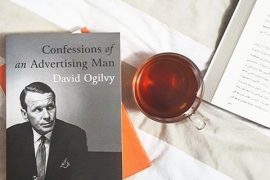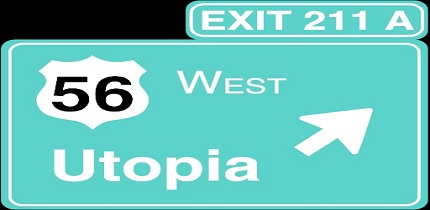What is Guerrilla marketing, and what makes it better than traditional marketing? And why is it especially suitable for small businesses.
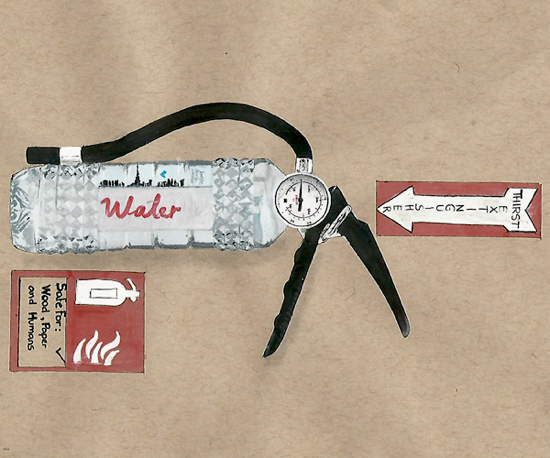
I know what you’re thinking and no, this has nothing to do with the banana-loving tree-swingers. Guerrilla Marketing is an approach introduced back in 1984, by Jay Levinson, an advertising executive (Wallace, 1989). It’s a form of advertising that is nothing like traditional advertising, it is distinguished, unusual, and unconventional. Or an even better description of it would be “Guerrilla marketing is advertising with a wink” (Connolly, 2007). Alright, I’m done with the riddles, brace yourself reader, it’s going to get wordy.
The traditional methods of advertising no longer hold the same impact, which is no surprise considering that traditional advertising has proven to be less effective in reaching consumers (Ives, 2004). It’s a shame because businesses invest big money in such advertising when there exists a better way. Guerrilla marketing is a better way in every sense of the word; it is more effective, more engaging, and less costly. All you need to invest in Guerrilla marketing is time, energy, and imagination. “Money helps,” Levinson says but adds that it’s not as necessary as those three key essentials. (Bernard and Saucet, 2017). This is why Levinson recommends small businesses owners to adopt such an approach (Wallace, 1989).
Guerrilla marketing is, of course, suitable for big businesses as well, and from the many Guerrilla ads I’ve seen, an increasing number of them have joined the Guerrilla side. It’s contagious because it hits multiple targets at once. People notice it, engage with it, like it and therefore like the brand. It all depends on your creativity and execution, you just need to think of a fun way to reach your customers. Whether your goal was to advertise a product, a service, or good old community service, you can go Guerrilla about it. Once you got that all planned, head out to the streets and execute.
The street is the natural habitat for Guerrilla marketers, it’s where they exercise their creativity. It is a platform that offers an opportunity to connect with consumers, an opportunity to surprise them, excite them, and get them talking (Bernard and Saucet, 2017). Guerrilla marketing helps you standout among your competitors, and positions your brand in the minds of consumers as fun and different.
An example of using the street in the Guerrilla way is this great stunt by Vodafone, a big mobile operator. Cell phone theft is very common in Romania that it has become a national issue. Still, consumers don’t feel the need to insure their phones against loss. So, professional pickpockets were hired to go on the streets and slip flyers into people’s pockets and purses. “It’s this easy to steal your phone,” it reads “Insure your phone at Vodafone”1. What better way to get your point across than to prove it? This Guerrilla tactic surely left a stronger impact, and succeeded in raising awareness about the problem.
Guerrilla marketers have to pay attention to context and consider the circumstances of the target consumers, like the theft problem in the previous example was used as inspiration to create that Guerrilla move. This coming example also used context, it’s the “pay with a smile” campaign in 2012 by Havas Worldwide, an advertising agency in Australia. The team started roaming the streets handing out cookies and only asking for a smile in return. Filmed as a TV ad, and attributed the campaign to a recent high percentage of unhappy commuters. That action makes people build a positive association with the brand, it’s a friendly thing to do, to care about the community. To watch this ad, click here: https://www.youtube.com/watch?v=-cRXRxepsKo
Guerrilla marketing has to be creative, surprising, and unconventional either in execution or placement. In the previous examples, creativity was geared toward execution. As for creativity in placement, take for instance, McDonald’s McFries Pedestrian Crossing in Switzerland in 2010. Placing an ad as street graffiti instead of a sign works because it still reminded the passerby of the Mcdonald’s across the street in an unusual way, elevating the consumer experience.
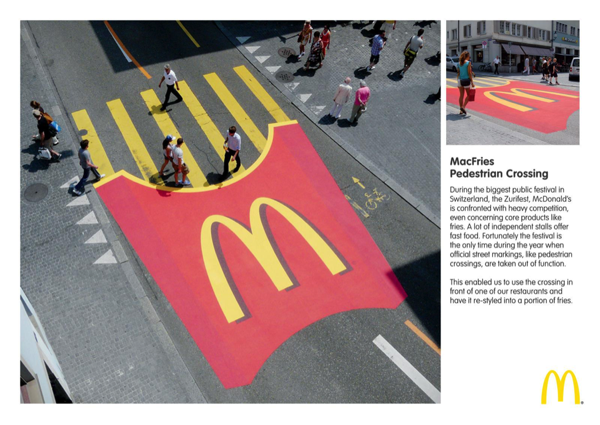 Advertising Agency: TBWA Switzerland Brand: MacDonald’s “MacFries Pedestrian Crossing” in 2010.
Advertising Agency: TBWA Switzerland Brand: MacDonald’s “MacFries Pedestrian Crossing” in 2010.
Source: Ads of the world.
Another “gripping” example is that placed at bus stations in France in 2009. Ads that are made of Velcro that stick to the clothes of anyone standing too close, because it’s the new ‘Grip’ bottle by Coca Cola. Target audiences are more likely to talk about it with others, while it’s hard to imagine a context where they talk about an ordinary Coke ad.
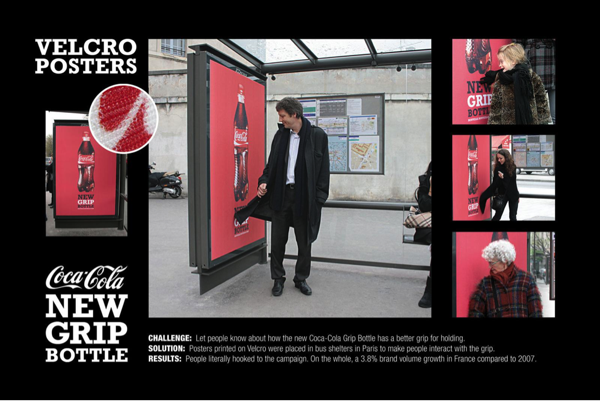
Advertising Agency: Marcel, France. Brand: Coca Cola “Grip Bottle” in 2009.
Source: Ads of the world.
What Guerrilla Marketing achieves is so much more than an increase in sales. It contributes to brand loyalty, and builds positive associations. Making the brand more human and less like a corporation that’s just trying to take their money. Creativity can go a long way, and remember, you don’t need a big budget, you can work with what you have. Here are video examples of guerrilla marketing for you to watch and learn:
Volkswagen’s “Speed up your life” campaign: https://www.youtube.com/watch?v=W4o0ZVeixYU
TNT’s “push to add drama” campaign: https://www.youtube.com/watch?v=316AzLYfAzw&t=26s
References:
- http://www.marketing-schools.org/types-of-marketing/guerrilla-marketing.html
- Connolly, Chris. “Six Great Guerrilla Marketing Campaigns.” CNN. Cable News Network, 13 Nov. 2007. Web. 14 July 2017. <http://edition.cnn.com/2007/LIVING/11/13/guerrilla.marketing/>.
- Cova, Bernard, and Marcel Saucet. “Unconventional Marketing: From Guerrilla to Consumer Made.” Social Science Research Network Electronic Paper Collection (2017): n. pag. Web. 15 July 2017.
- Linda S. Wallace (March 12, 1989). “‘Guerrilla marketing’ gives small firms the edge”. Lawrence Journal-World. Retrieved June 5, 2017.
- “How to Pull Off a Guerrilla Marketing Campaign.” Entrepreneur. Entrepreneur Media, Inc., 18 Apr. 2010. Web. 14 July 2017. <https://www.entrepreneur.com/article/206202>.
- Ives, Nat. “Guerrilla Campaigns Are Going to Extremes, but Will the Message Stick?” The New York Times. The New York Times, 23 June 2004. Web. 14 July 2017. <http://www.nytimes.com/2004/06/24/business/media-business-advertising-guerrilla-campaigns-are-going-extremes-but-will.html>.
